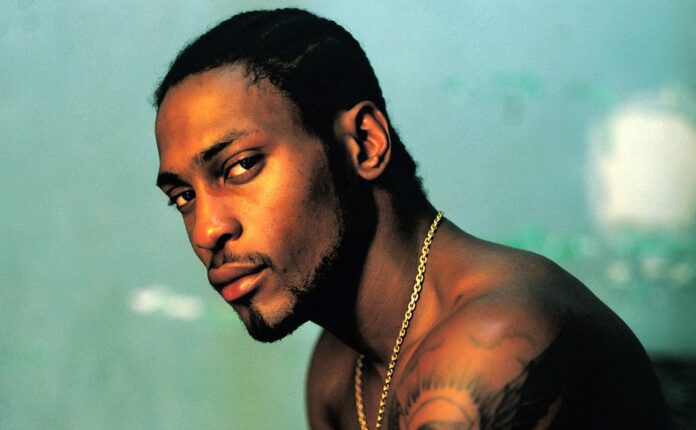The artist pays the price/so you won’t have to pay/if only we would listen/to what they have to say
—”Life Is for Learning,” Marvin Gaye
There is a five-year gap between the albums Brown Sugar and Voodoo. D’Angelo experienced writer’s block, which could be due to the pressure—straight-up weight—of following up a genre-changing debut album with something not just better, but from deep within himself.
Brown Sugar, from 1995, had a little bit of everything for everyone. Moody joints like the title cut “Brown Sugar” and “Me and Those Dreamin’ Eyes of Mine” for the hip-hop set; real R&B joints like “Lady” and “Alright” that made women, predominantly Black women, feel single, real quick; and throwback songs from previous eras that showed his versatility.
He was so with it, he reworked a Smokey Robinson tune—a no-no in the culture, you don’t mess with Unc—and made it his own. That’s NFL-level, Alpha type of swag coming from this dude in cornrows, baggy jeans, wearing Tims. Yep, that dude crafted a version of “Cruisin” for us, the Black Gen X’ers, that was so legit, old heads, the ones who vowed never to get or dig hip-hop, just could not deny it. And that’s the thing with D’Angelo, that’s got everybody real hurt, messed up inside with his passing.
He possessed the entire bag.
Michael D’Angelo Archer, a Richmond, Virginia native, cross-generational R&B artist and one of the backbone figures of the neo-soul movement that grew Black music forward in the ’90s, passed away on October 14. D’Angelo’s family confirmed that the cause of his death was pancreatic cancer. He was 51.
When Voodoo was unleashed in early 2000, it wasn’t just a miracle and a movement in sound; it was part of a collective in Black music that was determined to make soul and R&B not just disposable “club music” or pop; it would be along the lines of an institution; soul music recontextualized through a Black backpackers’ filter. He went back and studied at the altar of Al Green, Marvin Gaye, Parliament Funkadelic, Sly Stone, Bob Marley, James Brown, Jimi Hendrix, while also taking something away from the passing of both Notorious B.I.G. and Tupac.
D. knew this music meant far more than just a silly MTV video and a shiny suit. Yeah, I said it.
In an interview for Ebony, D’Angelo divulged why Voodoo needed to happen: “I consider myself very respectful of the masters who came before. In some ways, I feel a responsibility to continue and take the cue from what they were doing musically and vibe on it. That’s what I want to do. But I want to do it for this time and this generation.”
Co-produced with Questlove, DJ Premier, and Raphael Saadiq, the album saw D’Angelo bring in an extensive line-up of musicians known as the Soulquarians musical collective. With the late trumpeter Roy Hargrove, Bay Area legend Charlie Hunter, bassist Pino Palladino, songwriter Erykah Badu, and so many more on hand, the goal was to make music that would remain evergreen, through the muddy, live, and raw in-the-moment feel, basically going in the opposite direction of everything at the time that sounded quantized and devoid of stink and sweat, of human touch.
With dudes crooning on beaches, or in their McMansion on “MTV Cribs”, there was no struggle, no tension; it was all aimed at a performative image. Not-musical.
I doubt it was intentional, but D did that Sade thing. Which made him Gawd-like even when he was battling demons. He went hard on everything he released, and I’m talking about his covering Prince’s “She’s Always In My Hair” on down. (Bruh, tuned up Prince too.)
But he released music when he thought it was needed. Not on a hamster wheel. This made him highly respected in the culture worldwide. So when he spoke, folks lent an ear to the speaker.
One of the songs from Voodoo, “Devil’s Pie,” released in 1998—featured on the “Belly” soundtrack and originally meant for Canibus but later offered to D’Angelo by DJ Premier—is a raw and gritty sermon. Hip-hop soul that tells a story about how far people will go to make a buck. D’Angelo found his track to speak at folks a little in the club, because the vibe is undeniable. As soon as that bass line dropped, heads are nodding and bobbin’, the dancefloor would swell, and then he’d start preachin’. According to an interview done with Questlove in 1999, the song was written to address the issues of “the money hungry jiggafied state of the world we’re in, which you can’t eat without dough, cream, ice, cheddar, and bread (the key ingredients) and how the devil will destroy those who will sell their souls to him.”
Mmm.
Meanwhile, the video for “Untitled (How Does It Feel)” made him a star, sex symbol, and left him feeling wholly uncomfortable. While the song stayed on rotation on MTV, which was the point—to get that video into the heavy rotation—his performance, appearing somewhat naked and totally in shape, made D’Angelo feel like maybe everyone fast-forwarded past the music and just focused on the flesh. It was a feeling that Marvin Gaye had when he, too, would tour and women would throw their panties on stage.
Voodoo would win both Best R&B Album in 2001 and Best Male R&B Vocal Performance that same year.
He’d wait again, this time for a decade, before releasing Black Messiah under the name D’Angelo and The Vanguard in late 2014, with a full band, donning a doo-rag and a corner smile and a recently picked-up electric guitar. Again, he won a Grammy for Best R&B album.
While I never saw him perform live in concert, many a night, DJing throughout the Bay Area at predominantly Black events in the late ’90s and early 2000s—not hip-hop parties, that’s quite different, but these events within the culture—I saw, witnessed, rather, his “Devil’s Pie” sermon send my people home right. Everytime.
RIP D’Angelo





